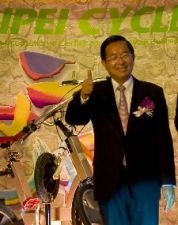TAIPEI, Taiwan (BRAIN)—Taiwan’s president topped the crowd of dignitaries marking the official opening of the Nangang Exhibition Hall Thursday and the start of the Taipei Cycle show.
“Taiwan’s high-quality products are now well received internationally,” said President Chen Shui-bian, who is nearing the end of eight years in office.
He praised the A-Team, the association of leading Taiwan bicycle makers, saying its members “have made a marvelous contribution to high-quality, international image of local products.”
The $110-million Nangang convention center, Asia’s newest, boasts nearly twice as much space as the old facility in downtown Taipei. The bicycle show is the first to be held in the building and, outside of a few glitches, exhibitors took advantage of the space to expand their booths—a luxury impossible at the old Taiwan World Trade Center.
Exhibitors were pleased with the new digs, but most groused over the lack of nearby lodging. Many overseas visitors are staying at downtown hotels and face a 25- to 30-minute bus ride through Taipei’s morning traffic to reach the new convention center.
While the opening ceremonies gave industry leaders an opportunity to boast of Taiwan’s resurgence as a major center of manufacturing, the topic of conversation in the hallways centered on pricing. It’s not whether prices will go up, but by how much. Somewhere between 12 and 20 percent seems to be the going range. And U.S. dealers will have to cope with it.
Most U.S. executives seem reluctant to talk on the record as yet over price hikes since there is so much uncertainty. One of the top priorities for brands at Taipei Cycle, which ends Sunday, is to hammer out pricing with suppliers. But all agree that factories in China and Taiwan have little choice but to pass on higher costs.
One executive, for example, said the cost of bringing a container by ocean freight from Europe to the U.S. rose from $2,400 several years ago to more than $6,000 this year. Fuel surcharges on all air and ground freight—UPS, FedEx, DHL and others—have skyrocketed as oil prices spiral well past $100 a barrel.
And that’s on top of price increases for raw materials such as aluminum, steel, carbon fiber and plastic. Further complicating the price structure are inflation, rising wages and pending pension reforms in China, the weakening dollar, the robust euro as well as China’s revaluation of the yuan and reduction of favorable tax treatment for mainland China manufacturers.
Still, Thursday’s ceremony gave this island nation and its bicycle and accessory suppliers an opportunity to point out that they exported more than 4.75 million bicycles last year—up 16 percent from 2006—with a value of more than $1.05 billion dollars.
In three years, the average wholesale price of a complete bike made in Taiwan has leaped from $154 per unit to more than $221.
PHOTO by Doug McClellan: Taiwan President Chen Shui-bian presided over the opening of the country’s new convention center, and the Taipei Cycle show, on Thursday.
—Marc Sani




